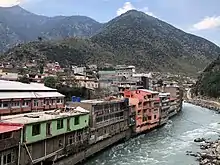| Torwali | |
|---|---|
| توروالی | |
 Torwali written in Perso-Arabic in Nastaliq style. | |
| Region | Swat District |
| Ethnicity | Torwali people |
Native speakers | 130,000 (2020)[1] |
Indo-European
| |
| Arabic script (primarily Nastaliq) | |
| Language codes | |
| ISO 639-3 | trw |
| Glottolog | torw1241 |
| ELP | Torwali |
 Torwali is a minor language of Pakistan which is mainly spoken by Torwali nation of Central Swat District, it is given a space in this map. | |

Torwali (توروالی) is an Indo-Aryan language spoken by the Torwali people, and concentrated in the Bahrain and Chail areas of the Swat District in Pakistan.[2][3][4][5] The Torwali language is said to have originated from the pre-Muslim communities of Swat.[6] It is the closest modern Indo-Aryan language still spoken today to Niya, a dialect of Gāndhārī, a Middle Indo-Aryan language spoken in the ancient region of Gandhara.[7][8]
Torwali is an endangered language: it is characterised as "definitely endangered" by UNESCO's Atlas of Endangered Languages,[9] and as "vulnerable" by the Catalogue of Endangered Languages.[10] There have been efforts to revitalize the language since 2004, and mother tongue community schools have been established by Idara Baraye Taleem-o-Taraqi (IBT).[11]
Phonology
Although descriptions of Torwali phonology have appeared in the literature, some questions still remain unanswered.[12][13]
Vowels
| Front | Central | Back | |
|---|---|---|---|
| Close | i iː | u uː | |
| Mid | e eː | o oː | |
| Open | a aː |
Edelman's analysis, which was based on Grierson and Morgenstierne, shows nasal counterparts to at least /e o a/ and also found a series of central (reduced?) vowels, transcribed as: ⟨ä⟩, ⟨ü⟩, ⟨ö⟩.[12]
| Front | Central | Back | |
|---|---|---|---|
| Close | i ĩ | (ɨ̙) | u ũ |
| Mid | e ẽ (e̙) | ə (ə̙) | o õ |
| Open | æ æ̃ | a ã |
Lunsford had some difficulty determining vowel phonemes and suggested there may be retracted vowels with limited distribution: /ɨ/ (which may be [i̙]), /e̙/, /ə̙/.[13] Retracted or retroflex vowels are also found in Kalash-mondr.[14]
Consonants
The phonemic status of the breathy voiced series is debatable.
Sounds with particularly uncertain status are marked with a superscript question mark.
| Labial | Coronal | Retroflex | Post-alv./ Palatal |
Velar | Glottal | |||||||
|---|---|---|---|---|---|---|---|---|---|---|---|---|
| Nasal | m | n | (ɳ) | ŋ | ||||||||
| Stop | p pʰ | b bʱ |
t tʰ | d dʱ |
ʈ ʈʰ | ɖ ɖʱ |
k kʰ | g ɡʱ |
||||
| Affricate | ts | ʈʂ ʈʂʰ | ɖʐ |
tʃ tʃʰ | dʒ |
|||||||
| Fricative (Lateral) |
s | z | ʂ | ʐ | ʃ | ʒ | x | ɣ | h | |||
| (t)ɬ? | ||||||||||||
| Approximant (Lateral) |
j | w | ||||||||||
| l | ||||||||||||
| Rhotic | r | ɽ? | ||||||||||
Alphabet
The Torwali language does not have a fixed orthography.[15] here have been many proposals, which have seen limited use by the speakers, though there has been heavy work done for the language in recent years with the help of Zubair Torwali and Rehmat Aziz Chitrali.[16] Here is one of the proposals created by Zubair Torwali which is used in Swat:
| Letter | Romanization | IPA |
|---|---|---|
| آ | ā | /aː/ |
| أ | a | /a/ |
| اَ | ʿ | /ʔ/ |
| ب | b | /b/ |
| پ | p | /p/ |
| ت | t | /t/ |
| ٹ | ṭ | /ʈ/ |
| ث | (s) | /s/ |
| ج | ǰ | /d͡ʒ/ |
| چ | č | /t͡ʃ/ |
| ڇ | ċ | /ʈ͡ʂ/ |
| څ | c | /t͡s/ |
| ح | (h) | /h/ |
| خ | x | /x/ |
| د | d | /d/ |
| ڈ | ḍ | /ɖ/ |
| ذ | (z) | /z/ |
| ر | r | /r/ |
| ڑ | ṛ | /ɽ/ |
| ز | z | /z/ |
| ڙ | ż | /ʐ/ |
| ژ | ž | /ʒ/ |
| س | s | /s/ |
| ش | š | /ʃ/ |
| ݜ | ṣ | /ʂ/ |
| ص | (s) | /s/ |
| ض | (z) | /d/ |
| ط | (t) | /t/ |
| ظ | (z) | /z/ |
| ع | ʿ | /ʔ/ |
| غ | ǧ | /ɣ/ |
| ف | f | /f/ |
| ق | q | /q/ |
| ک | k | /k/ |
| گ | g | /ɡ/ |
| ل | l | /l/ |
| م | m | /m/ |
| ن | n | /n/ |
| ں | ◌̃ | /◌̃/ |
| و | w | /v~w/ |
| او | o | /oː/ |
| اُ | u | /u/ |
| اُو | ú | /ú/ |
| ہ | h | /h/ |
| ھ | _h | /ʰ/ |
| ی | y | /j/ |
| ے | e | /e/ |
Chitrali and Kohistani Alphabet
The Torwali language in Chitral and Kohistan uses loanwords from Khowar and Indus Kohistani, the dominant languages in the region, which uses another letter, ݲ, which is used to represent [ɖ͡ʐ].[17] They also use the Pashto letter ځ to represent [d͡z].[18]
References
- ↑ Torwali at Ethnologue (26th ed., 2023)

- ↑ Kreutzmann, Hermann (2005). "Linguistic diversity in space and time: A survey in the Eastern Hindukush and Karakoram". Himalayan Linguistics. Center for Development Studies, Free University of Berlin. 4: 7.
- ↑ Torwali, Zubair (2016). "Reversing Language Loss through an Identity Based Educational Planning: The Case of Torwali language" (PDF). Eurasian Journal of Humanities. 1 (2): 24.
- ↑ Biddulph, John (1880). Tribes of the Hindoo Koosh (PDF). Graz, Austria: 1971 edition Akadmeische Druck u Verlagasasntalt. p. 69.
- ↑ Barth, Fredrik (1956). Indus and Swat Kohistan: an Ethnographic Survey. Oslo. p. 52.
{{cite book}}: CS1 maint: location missing publisher (link) The Pathans call them, and all other Muhammadans of Indian descent in the Hindu Kush valleys, Kohistanis. - ↑ Torwali, Zubair (4 March 2019). "Revitalization of Torwali poetry and music". We Mountains – Regional Website of North Pakistan. IBT. Retrieved 5 March 2019.
- ↑ Burrow, T. (1936). "The Dialectical Position of the Niya Prakrit". Bulletin of the School of Oriental Studies, University of London. 8 (2/3): 419–435. ISSN 1356-1898. JSTOR 608051.
... It might be going too far to say that Torwali is the direct lineal descendant of the Niya Prakrit, but there is no doubt that out of all the modern languages it shows the closest resemblance to it. A glance at the map in the Linguistic Survey of India shows that the area at present covered by "Kohistani" is the nearest to that area round Peshawar, where, as stated above, there is most reason to believe was the original home of the Niya Prakrit. That conclusion, which was reached for other reasons, is thus confirmed by the distribution of the modern dialects.
- ↑ Salomon, Richard (1998-12-10). Indian Epigraphy: A Guide to the Study of Inscriptions in Sanskrit, Prakrit, and the other Indo-Aryan Languages. Oxford University Press. p. 79. ISBN 978-0-19-535666-3.
- ↑ Torwali, Zubair (2016). "Reversing Language Loss through an Identity Based Educational Planning: The Case of Torwali language" (PDF). Eurasian Journal of Humanities. 1 (2): 24.
- ↑ Hammarström, Harald. "Torwali". Glottolog. Retrieved 17 April 2019.
- ↑ Liljegren, Henrik (2018). "Supporting and Sustaining Language Vitality in Northern Pakistan". The Routledge Handbook of Language Revitalization. pp. 427–437. doi:10.4324/9781315561271-54. ISBN 978-1-315-56127-1.
- 1 2 3 Èdel'man, Džoj Iosifovna (1983). The Dardic and Nuristani languages. Nauka. OCLC 1014554012.
- 1 2 3 Lunsford, Wayne A. (2001). An overview of linguistic structures in Torwali, a language of Northern Pakistan (PDF) (Thesis). pp. 26–30. OCLC 48846858.
- ↑ Kochetov, Alexei; Arsenault, Paul (2008), Retroflex harmony in Kalasha: Agreement or spreading? (PDF), NELS, vol. 39, Cornell University, p. 4
- ↑ Torwali, Zubair (2020). "Adapting the Multilingual Assessment Instrument for Narratives (MAIN) to Torwali".
- ↑ "The Torwali language and its new Android keyboard". 10 March 2017.
- ↑ "Torwali Alphabet". October 2020.
- ↑ "Torwali alphabet, pronunciation and language".
Bibliography
- Biddulph, John (1880). "Tribes of the Hindukush".
- Grierson, George Abraham (1929). Torwali: An Account of a Dardic Language of the Swat Kohistan. Asian Educational Services. ISBN 978-81-206-1605-9.
- Ullah, Inam (2004). "Lexical database of the Torwali Dictionary", paper presented at the Asia Lexicography Conference, Chiangmai, Thailand, May 24–26.
- Endangered Languages Project; http://www.endangeredlanguages.com/lang/3501/guide
- SoundCloud https://soundcloud.com/zubairtorwali/sets/manjoora-torwali-melodies
- Library of Congress https://books.google.com/books?id=JHLalS4Jp1oC&dq=Torwali&pg=PA7522
- Jalal Uddin https://paperswithcode.com/paper/a-step-towards-torwali-machine-translation-an
- Torwali, Zubair (2015). Muffled voices: longing for a pluralist & peaceful Pakistan. Multi Line Publications. ISBN 978-969-8985-06-6.
- Ahmad, Aftab (2015) Torvālī Urdū, angrezī lug̲h̲at = Torwali-Urdu-English dictionary https://trove.nla.gov.au/version/243822077
External links
- https://dsal.uchicago.edu/dictionaries/torwali/ A digital Torwali-English dictionary with audio
- https://182.180.102.251:8081/otd/HomePage.aspx/ Online Torwali-Urdu Dictionary (Center for Language Engineering at UET, Lahore Pakistan)
- https://www.unesco.org/culture/ich/doc/src/00851-EN.doc (UNESCO Register of Good Practices in Language Preservation)
- Jalal Uddin https://www.aclweb.org/anthology/W19-6802
- http://torwaliresearchforums.org/ A website providing information about Torwali language and computational developments made in Torwali language. Jalaluddin
- https://web.archive.org/web/20151208134056/http://torwali.base.pk/ A website providing information about the Torwali language and the history of the Torwali people. Includes photos, classification, etc.
- https://www.torwali.org a website managed by the Swat based organization Idara Baraye Taleem-o-Taraqi (IBT) i.e institute for education and development, that works for the integrated development of the ethno-linguistic communities of Pakistan including the Torwalis.
- https://torwali.omeka.net/ An Endangered Language Project created by Amber Khan for English 318 at Southern Illinois University Edwardsville
- Ahmad, Aftab (2016) Reversing language loss through identity based educational planning—the case of the Torwali language . http://www.lc.mahidol.ac.th/mleconf/2016/Documents/PresentedFiles/Parallel%20VI/T3-9/5C-Aftab%20Ahmad.pdf